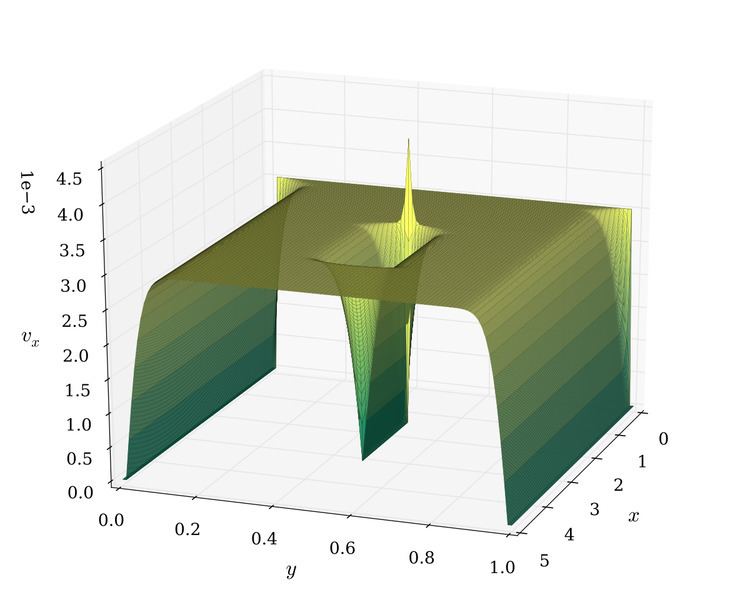 | ||
In mathematics, finite-difference methods (FDM) are numerical methods for solving differential equations by approximating them with difference equations, in which finite differences approximate the derivatives. FDMs are thus discretization methods.
Contents
- Derivation from Taylors polynomial
- Accuracy and order
- Example ordinary differential equation
- Example The heat equation
- Explicit method
- Implicit method
- CrankNicolson method
- Comparison
- References
Today, FDMs are the dominant approach to numerical solutions of partial differential equations.
Derivation from Taylor's polynomial
First, assuming the function whose derivatives are to be approximated is properly-behaved, by Taylor's theorem, we can create a Taylor Series expansion
where n! denotes the factorial of n, and Rn(x) is a remainder term, denoting the difference between the Taylor polynomial of degree n and the original function. We will derive an approximation for the first derivative of the function "f" by first truncating the Taylor polynomial:
Setting, x0=a we have,
Dividing across by h gives:
Solving for f'(a):
Assuming that
Accuracy and order
The error in a method's solution is defined as the difference between the approximation and the exact analytical solution. The two sources of error in finite difference methods are round-off error, the loss of precision due to computer rounding of decimal quantities, and truncation error or discretization error, the difference between the exact solution of the original differential equation and the exact quantity assuming perfect arithmetic (that is, assuming no round-off).
To use a finite difference method to approximate the solution to a problem, one must first discretize the problem's domain. This is usually done by dividing the domain into a uniform grid (see image to the right). Note that this means that finite-difference methods produce sets of discrete numerical approximations to the derivative, often in a "time-stepping" manner.
An expression of general interest is the local truncation error of a method. Typically expressed using Big-O notation, local truncation error refers to the error from a single application of a method. That is, it is the quantity
the dominant term of the local truncation error can be discovered. For example, again using the forward-difference formula for the first derivative, knowing that
and with some algebraic manipulation, this leads to
and further noting that the quantity on the left is the approximation from the finite difference method and that the quantity on the right is the exact quantity of interest plus a remainder, clearly that remainder is the local truncation error. A final expression of this example and its order is:
This means that, in this case, the local truncation error is proportional to the step sizes. The quality and duration of simulated FDM solution depends on the discretization equation selection and the step sizes (time and space steps). The data quality and simulation duration increase significantly with smaller step size. Therefore, a reasonable balance between data quality and simulation duration is necessary for practical usage. Large time steps are useful for increasing simulation speed in practice. However, time steps which are too large may create instabilities and affect the data quality.
The von Neumann method is usually applied to determine the numerical model stability.
Example: ordinary differential equation
For example, consider the ordinary differential equation
The Euler method for solving this equation uses the finite difference quotient
to approximate the differential equation by first substituting it for u'(x) then applying a little algebra (multiplying both sides by h, and then adding u(x) to both sides) to get
The last equation is a finite-difference equation, and solving this equation gives an approximate solution to the differential equation.
Example: The heat equation
Consider the normalized heat equation in one dimension, with homogeneous Dirichlet boundary conditions
One way to numerically solve this equation is to approximate all the derivatives by finite differences. We partition the domain in space using a mesh
will represent the numerical approximation of
Explicit method
Using a forward difference at time
This is an explicit method for solving the one-dimensional heat equation.
We can obtain
where
So, with this recurrence relation, and knowing the values at time n, one can obtain the corresponding values at time n+1.
This explicit method is known to be numerically stable and convergent whenever
Implicit method
If we use the backward difference at time
This is an implicit method for solving the one-dimensional heat equation.
We can obtain
The scheme is always numerically stable and convergent but usually more numerically intensive than the explicit method as it requires solving a system of numerical equations on each time step. The errors are linear over the time step and quadratic over the space step:
Crank–Nicolson method
Finally if we use the central difference at time
This formula is known as the Crank–Nicolson method.
We can obtain
The scheme is always numerically stable and convergent but usually more numerically intensive as it requires solving a system of numerical equations on each time step. The errors are quadratic over both the time step and the space step:
Usually the Crank–Nicolson scheme is the most accurate scheme for small time steps. The explicit scheme is the least accurate and can be unstable, but is also the easiest to implement and the least numerically intensive. The implicit scheme works the best for large time steps.
Comparison
The figures below present the solutions given by the above methods to approximate the heat equation
with the boundary condition
The exact solution is
